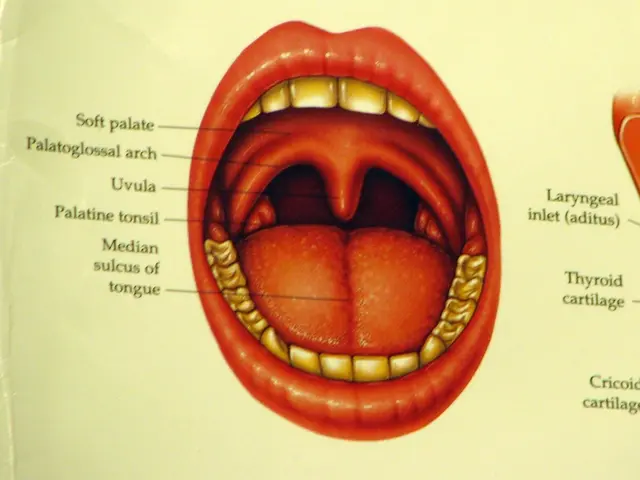Eye Movement Desensitization and Reprocessing (EMDR): A Modern Trauma Therapy
EMDR Treatment for Stress Disorders, Post-Traumatic Stress, Anxiety, and Sudden Fears
What's the deal with EMDR, you ask? Eye Movement Desensitization and Reprocessing (EMDR) is a trailblazing therapy for trauma and distressing events, developed by psychologist Dr. Francine Shapiro. Its roots come from an interesting observation—that eye movements can reduce the intensity of disturbing thoughts—made during a relaxing stroll in the park one fine day.
EMDR involves recalling a past event, and then "rewiring" the memory using a new, positive belief, all while employing rapid eye movements to aid the process. The science behind why it works is still taking shape, but many folks have found it incredibly helpful.
EMDR seamlessly combines elements of cognitive-behavioral therapy (CBT) with bilateral eye movements or alternative rhythmic stimulations, such as alternating hand taps or chimes that move back and forth from ear to ear. It's the dual stimulation that's key to EMDR—during treatment, you'll think or talk about memories, triggers, and emotions related to your trauma or condition, while focusing on a moving stimulus.
How Does EMDR Work its Magic?
When faced with a traumatic event, intense emotions can impede your ability to fully process the event. That unpleasant moment then becomes "stuck in time." Recalling the event can feel like reliving it over and over, as the sights, smells, sounds, and feelings are still fresh and easy to trigger.
When triggered, these memories can interfere with your daily life, alter your self-perception, and affect your relationships with others. EMDR appears to work by unfreezing these traumatic memories, allowing them to be resolved.
Over time, you'll work through the distressing memories and associated feelings, reaching a point where you can think about the event without reliving it. The memory remains, but it's less distressing.
Treatment Effects
Using rapid eye movements seems to alleviate the anxiety surrounding the trauma, so that you can see the experience from a more detached perspective, like watching a movie. This enables you to reframe the original trauma and release the stored negative emotional energy.
Some believe it reactivates parts of the brain that were "switched off" during the traumatic experience. This way, your brain reconsiders the experience, allowing the negative, painful emotions to give way to more resolved, empowering feelings.
Some experts have noted that the eye movements in EMDR might be similar to what happens naturally during dreaming or REM (rapid eye movement) sleep. It lets you view experiences in a new and less distressing way.
Speak to a Licensed Therapist
Ready for a change? BetterHelp is an online therapy service that pairs you with licensed, accredited therapists who can help with depression, anxiety, relationships, and more. Take the assessment and get matched with a therapist in as little as 48 hours.
Take Assessment
When Memories Trap You: How One Trauma Can Affect Your Life
Dr. Francine Shapiro, the inventor of EMDR, illustrates the impact of trauma using the example of a rape survivor.
Even though a woman who has been raped might understand intellectually that she's not to blame, she may still wrestle with feelings of guilt and shame surrounding the attack. Her memory of the rape is then forever tainted by these emotions that she hasn't fully explored or dealt with.
Shapiro contends that as time goes by, "when the individual thinks about the trauma or when the memory is triggered by similar situations, the person may feel like she is reliving it, or may experience strong emotions and physical sensations."
The 8 Phases of EMDR Therapy: Phases 1-3
EMDR can work wonders, but it's important to follow the entire 8-phase process with a skilled EMDR therapist to ensure the most beneficial and lasting results.
EMDR Phase 1: History and Treatment Planning
Your initial session will likely involve your therapist taking your history. They'll ask about the problems, behaviors, and fears that have led you to therapy. However, unlike many other therapies, you won't spend too much time delving into the details of the traumatic event. Instead, your emotions and physical sensations surrounding the event matter most.
Once your therapist has developed a treatment plan for you based on this initial assessment, the process of EMDR can begin.
EMDR Phase 2: Preparation
The preparation stage involves your therapist teaching you some self-care techniques so you can manage any strong emotions that might arise during or between sessions. EMDR places heavy emphasis on self-care.
This stage is also critical for building trust with your therapist. They'll explain the theory of EMDR in more detail and discuss what you can expect during the upcoming sessions.
EMDR Phase 3: Assessment
Phase 3 forms the foundation for your actual EMDR therapy sessions. During this assessment phase, your therapist will ask you to identify:
- A specific scene or image representing the traumatic event you're focusing on with this treatment.
- A negative belief about yourself associated with the traumatic event (e.g., "I am helpless," "I am worthless," or "I am a bad person").
- A positive belief you'd prefer to believe about yourself (e.g., "I am strong," "I am resilient," or "I am capable").
These three elements will then be rated on the Validity of Cognition (VOC) scale of 1-7 and the Subjective Units of Disturbance (SUD) scale of 0-10. This helps your therapist track your progress.
Processing the Trauma: EMDR Therapy Phases 4-6
Once you've completed the first three stages of EMDR therapy, the work of processing the trauma begins. In phases 4-6, your therapist will assist you in recalling your target image while guiding you through a series of rapid eye movements (or alternative stimuli like sound, tactile stimulation, or a mix).
As your attention is split between the internal image and the external stimuli of your therapist's moving finger, you're able to experience the distressing memory while staying grounded in the present, making it easier to process and reframe the trauma.
During your EMDR sessions, the therapist will monitor the intensity of your symptoms to ensure progress is being made and maintained. According to the EMDR Network, addressing a single trauma is typically accomplished within three sessions. Even if treatment takes longer, you should still see some improvement within that timeframe.
EMDR Phase 4: Desensitization
During the desensitization phase, you'll pay attention to all the negative beliefs and disturbing emotions and bodily sensations that surface. As you focus on your target image while following your therapist's finger with your eyes, you'll be asked to note your reactions—positive, negative, or neutral. You'll also be asked about any new insights, associations, or emotions that arise.
After each set of rapid eye movements, your therapist will check in with you and assess your level of disturbance regarding the target image. During this process, you'll continue to process the feelings, images, and beliefs related to the trauma.
The desensitization phase continues until your distress level, as measured by the SUD scale, drops to 0 or 1.
EMDR Phase 5: Installation
In the installation phase, you'll be asked to focus on the positive belief you've identified to replace the old negative belief about the trauma.
As in phase 4, you'll focus on this mental image while simultaneously tracking your therapist's finger with your eyes. Your goal is to strengthen the positive belief until you accept it as true.
After each set of rapid eye movements, the therapist will ask you to rate the positive belief on the 7-point VOC scale, giving the therapist concrete measures of your progress. The installation phase is complete once you accept the positive belief at a level of 7 ("completely true").
EMDR's distinctiveness lies in the rapidity at which new beliefs about yourself and your interpretations of the trauma can replace old beliefs. New possibilities often emerge that you've never considered before. These new insights can be used as the starting points for the next set of eye movements, continually helping you process the trauma in healthier, more manageable ways.
EMDR Phase 6: Body Scan
After replacing negative beliefs surrounding the trauma with healthy, positive beliefs, the next stage is to focus on any lingering physical sensations. Your therapist will ask you to think about your original target while performing a body scan, looking for any remaining tension.
Any residual bodily tension or uncomfortable physical sensations are then targeted until they're resolved. According to the EMDR Network, "positive self-beliefs are important, but they have to be believed on more than just an intellectual level." Phase 6 is deemed successful when you're able to think or talk about the original target without feeling any body tension or any other unpleasant physical sensations.
EMDR Therapy Phases 7-8
EMDR Phase 7: Closure
One of the goals of an EMDR therapy session is for you to leave feeling better than you did when you arrived. If you haven't been able to finish working through the target trauma during a session, your therapist will guide you through a variety of relaxation techniques. These draw from what you were taught in phase 2 and are designed to bring you back into emotional balance.
Your therapist will also prepare you for what you may experience between sessions. For example, disturbing images, thoughts, and emotions may arise during the week as you continue to process the trauma. Your EMDR therapist may suggest you keep a journal of these negative memories and thoughts. This can help you distance yourself from the unpleasant thoughts and provide you with new targets for future therapy sessions.
Your therapist may also review the visualization techniques and relaxation exercises you can use to maintain emotional balance between sessions.
EMDR Phase 8: Reevaluation
A new session kicks off with a reevaluation of your progress. First, you'll be asked to focus on any targets you've already reprocessed. Your therapist will review your responses, checking if you've maintained the positive results.
Your therapist may also ask how you feel about the previously-treated targets and review any negative emotions that came up between sessions. Based on this reevaluation, your therapist will decide whether to move on to new targets or revisit old targets for further reprocessing and integration.
The Advantages and Disadvantages of EMDR
EMDR therapy is still relatively new, born in 1987, and the scientific community continues to evaluate its long-term results. While opinions regarding its effectiveness vary, the main advantage lies in the speed at which deep-rooted problems can be resolved.
Single sessions of EMDR have been shown to yield results, and Dr. Francine Shapiro reports an average treatment time of five sessions for people with post-traumatic stress disorder (PTSD). To help decide if EMDR therapy is for you, consider the following:
Advantages of EMDR
- EMDR doesn't require you to go into detail about past traumatic events. Unlike many "talk" therapies, the trauma isn't analyzed for long periods.
- EMDR addresses your mind, body, and emotions all at once. This may account for its success in moving intellectual understanding of a problem ("I know I have guilt over my actions in war") to a resolution where post-traumatic symptoms clear up.
- The trauma that must be re-experienced during treatment is relatively brief. The reprocessing occurs simultaneously as the memory recall.
EMDR May Not Be Right for Everyone
- EMDR was designed as a trauma therapy and focuses on intensely stressful subjects.
- Pregnant women, or those with heart conditions, eye problems, or other health issues should consult their doctor before beginning EMDR therapy.
Research on EMDR
Despite its increasing popularity, ongoing debate exists within the psychological community about the scientific validity of EMDR, particularly when comparing it to other therapy types. Critics express doubt about the method's scientific basis and the paucity of research explaining how it works. On the other hand, numerous people have reported significant benefits from EMDR treatment, as have many studies published in peer-reviewed journals. Research also shows it can help treat PTSD in children and teens, and it seems to be about as effective as trauma-focused cognitive behavioral therapy (CBT).
Based on encouraging research results, both the American Psychological Association and the International Society of Traumatic Stress Studies have approved EMDR as a valid therapy for post-traumatic stress disorder.
EMDR has also been reported to have positive effects on other conditions, such as eating disorders, severe stress, unipolar depression, and anxiety disorders like Obsessive-Compulsive Disorder (OCD), panic disorder, and phobias. However, recent systemic reviews of EMDR research emphasize the need for higher-quality studies to gain a better understanding of its effectiveness.
Finding an EMDR Therapist
EMDR is a highly specialized therapy best provided by a licensed mental health professional with specific training in this complex approach. Some therapists are EMDR-trained, meaning they've completed EMDR basic training. Others are EMDR-certified, having conducted at least 50 EMDR sessions with patients and continuing their education.
EMDR therapy can also be provided online, so consider using an online therapy service if finding an in-person therapist proves difficult.
[Read: Finding a Therapist Who Can Help You Heal]
In addition to ensuring a therapist is certified to offer EMDR therapy, there are specific questions to ask a potential EMDR therapist:
- What is your training and experience with EMDR?
- Have you kept up to date on the latest protocols and developments?
- How many people with my specific problem have you successfully treated?
- Are there other therapies that you use besides EMDR for times when EMDR isn't the best fit for a client?
- What will we do if I become overwhelmed and don't want to continue during a session?
As well as offering the right experience to help you, seek out an EMDR therapist you feel comfortable with and who makes you feel understood and cared for.
[Author: Carol Corcoran, LCMFT, LMFT, and EMDR Certified Therapist]
[1] Friedman MJ, Resick PA, Brynaert MR, et al. A Randomized Controlled Trial of Eye Movement Desensitization and Reprocessing Therapy Versus Prolonged Exposure for Chronic Post-Traumatic Stress Disorder. Journal of Consulting and Clinical Psychology, 2007.
[2] Hembree E, Baker TM, Marquis AL. The Treatment of Acute and Chronic Stress Disorders. New York: Guilford Press, 2010.
[3] Van der Kolk B, Roth Hire, Caimano JA, et al. A Pilot Trial of Eye Movement Desensitization and Reprocessing Treatment in Abuse Survivors of Terror. Journal of Traumatic Stress, 2008.
[4] Schubert F (2004). Eye Movement Desensitization and Reprocessing (EMDR) with Traumatised Children. Proceedings of the 1st International Research Conference on EMDR, Boston.
[5] Seidler A, dos Reis M, Peris L, et al. FEMA National Disaster Child Traumatic Stress Consortium Child Cohort of Participants in the World Trade Center Building Collapse — New York City, 2003. MMWR Surveillance Summaries, 2004.
Science shows that Eye Movement Desensitization and Reprocessing (EMDR) therapies and treatments benefit both physical and mental health, particularly when it comes to managing stress and trauma. EMDR is proven to alleviate the anxiety surrounding traumatic events, helping individuals view experiences in a new and less distressing way, similar to the impacts of health-and-wellness practices on overall wellbeing. This opens up the door for mental-health improvements, fostering a more balanced and empowered state of mind.







